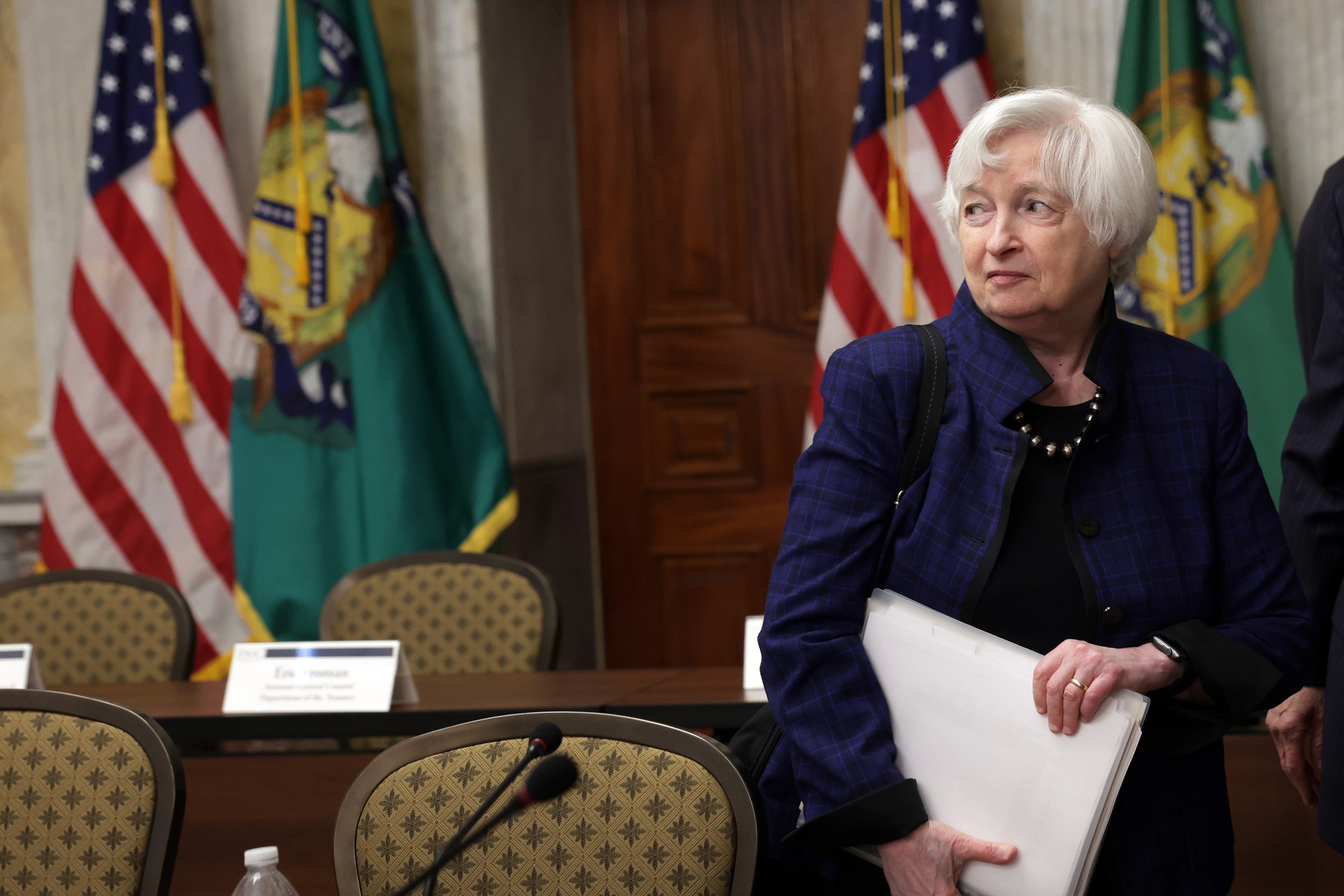How much does the U.S. owe China is a complex question with significant implications for global economics. HOW.EDU.VN provides expert insights into the intricacies of this topic, offering clarity and understanding. By exploring the U.S. debt landscape, we can analyze the role of foreign creditors and their impact on the American economy, examining both national debt and international finance.
1. Understanding the U.S. National Debt
The U.S. national debt is the total amount of money the U.S. federal government owes to its creditors. This debt accumulates over time through budget deficits, where the government spends more than it collects in revenue. To cover these deficits, the government issues securities like Treasury bonds, bills, and notes, which are then purchased by various entities, including domestic and foreign investors.
1.1. Components of the National Debt
The national debt can be broken down into two main categories:
- Debt Held by the Public: This is the portion of the national debt that is owned by individuals, corporations, state and local governments, foreign governments, and other entities outside of the federal government. It represents the government’s borrowing from the open market.
- Intragovernmental Holdings: This portion represents debt that one part of the government owes to another. For instance, various federal trust funds, such as Social Security and Medicare, invest their surpluses in Treasury securities. In essence, these are internal debts within the government.
1.2. The Debt Ceiling
The debt ceiling is a legal limit on the total amount of money the U.S. government can borrow to meet its existing legal obligations, including Social Security and Medicare benefits, military salaries, interest on the national debt, tax refunds, and other payments. Once the debt ceiling is reached, the Treasury Department must resort to extraordinary measures to continue funding government operations, such as temporarily suspending certain investments.
1.2.1. Consequences of Defaulting on the Debt
Defaulting on the national debt would have severe economic consequences. It could lead to:
- Delayed Payments: Social Security, Medicare, and other government payments could be delayed.
- Higher Borrowing Costs: Interest rates would likely rise, increasing the cost of borrowing for the government, businesses, and consumers.
- Stock Market Volatility: The stock market could experience significant declines due to uncertainty and loss of investor confidence.
- Economic Recession: A default could trigger a recession as businesses and consumers cut back on spending.
Addressing complex economic challenges like the debt ceiling requires specialized knowledge. At HOW.EDU.VN, our team of over 100 PhDs are equipped to provide guidance. Contact us for expert insight and assistance. Our address is 456 Expertise Plaza, Consult City, CA 90210, United States. You can also reach us via Whatsapp at +1 (310) 555-1212.
2. How Much Does the U.S. Owe China?
China is one of the largest foreign holders of U.S. debt. Understanding the specifics of this financial relationship is crucial for grasping the broader economic dynamics between the two countries.
2.1. Historical Context
China’s accumulation of U.S. debt is closely tied to its economic rise over the past few decades. As China transformed into a global manufacturing powerhouse, it generated significant trade surpluses, particularly with the United States. These surpluses resulted in a large accumulation of U.S. dollars.
2.1.1. Investment in U.S. Treasuries
Rather than holding these dollars as cash, China’s central bank, the People’s Bank of China (PBOC), invested a significant portion of them in U.S. Treasury securities. These securities are considered a safe and liquid investment, providing a store of value for China’s foreign exchange reserves. This investment helped stabilize the U.S. economy by keeping interest rates low and funding government spending.
2.2. Current Holdings
As of early 2024, China holds approximately $800 billion in U.S. debt, making it one of the largest foreign creditors, although Japan currently holds the largest share. This figure fluctuates based on economic conditions, trade dynamics, and investment decisions made by the PBOC.
2.3. Trends in China’s Holdings
Over the past decade, China’s holdings of U.S. debt have seen fluctuations. While it once was the largest foreign holder, China has gradually reduced its exposure to U.S. Treasuries.
2.3.1. Reasons for Decreasing Holdings
Several factors have contributed to this trend:
- Diversification of Reserves: China has been diversifying its foreign exchange reserves into other assets, such as gold, other currencies, and investments in infrastructure projects around the world.
- Trade Tensions: Trade tensions between the U.S. and China have influenced investment decisions.
- Domestic Economic Needs: China’s growing domestic economy requires more capital, leading to a reallocation of funds.
The expertise of seasoned professionals can be invaluable when navigating such intricate financial matters. At HOW.EDU.VN, our team includes over 100 PhDs ready to provide personalized consultations. Contact us at 456 Expertise Plaza, Consult City, CA 90210, United States, or via Whatsapp at +1 (310) 555-1212 for more information.
3. The Impact of U.S. Debt on China
U.S. debt holdings have significant implications for China’s economy and financial stability.
3.1. Economic Interdependence
The relationship between U.S. debt and China highlights the economic interdependence of the two nations. China’s investment in U.S. debt helps finance U.S. government spending and keeps interest rates low, benefiting the U.S. economy.
3.2. Risks for China
However, holding a substantial amount of U.S. debt also carries risks for China:
- Currency Risk: If the value of the U.S. dollar declines, the value of China’s U.S. debt holdings also decreases.
- Interest Rate Risk: Rising interest rates in the U.S. could lead to a decline in the value of existing U.S. Treasury securities.
- Geopolitical Risk: Political tensions between the U.S. and China could impact the stability and value of these holdings.
3.3. China’s Strategic Considerations
China’s decisions regarding its U.S. debt holdings are influenced by a variety of strategic considerations:
- Maintaining Economic Stability: China needs to ensure the stability of its foreign exchange reserves.
- Supporting Exports: Holding U.S. debt helps keep the value of the Chinese Yuan relatively stable, which supports its export-oriented economy.
- Geopolitical Influence: China’s economic power, including its holdings of U.S. debt, gives it leverage in international relations.
4. How Does U.S. Debt Compare to Other Countries?
The U.S. is not the only country with significant national debt. Comparing the U.S. debt to that of other major economies provides a broader perspective.
4.1. Debt-to-GDP Ratio
One common metric for comparing national debt levels is the debt-to-GDP ratio, which measures a country’s debt as a percentage of its gross domestic product (GDP). As of 2023, the U.S. debt-to-GDP ratio is over 120%, which is high compared to many other developed countries.
4.2. Major Economies
- Japan: Japan has one of the highest debt-to-GDP ratios in the world, exceeding 250%.
- Italy: Italy’s debt-to-GDP ratio is around 150%.
- Germany: Germany has a much lower debt-to-GDP ratio, at around 70%.
4.3. Factors Influencing Debt Levels
Several factors influence a country’s debt levels:
- Fiscal Policy: Government spending and taxation policies play a significant role.
- Economic Growth: Strong economic growth can help reduce the debt-to-GDP ratio.
- Demographics: Aging populations and increased healthcare costs can put pressure on government finances.
- Global Economic Conditions: Recessions and financial crises can lead to increased government borrowing.
For comprehensive financial advice, reach out to our experienced professionals at HOW.EDU.VN. Our team of over 100 PhDs is ready to provide the expertise you need. Contact us at 456 Expertise Plaza, Consult City, CA 90210, United States, or via Whatsapp at +1 (310) 555-1212 for more information.
5. The Role of Other Foreign Creditors
While China is a significant holder of U.S. debt, it is not the only foreign creditor. Other countries also hold substantial amounts of U.S. Treasury securities.
5.1. Japan
Japan is currently the largest foreign holder of U.S. debt, with holdings exceeding $1 trillion. Like China, Japan has accumulated U.S. debt through trade surpluses and investment in U.S. Treasury securities.
5.2. United Kingdom
The United Kingdom is another major foreign creditor, with holdings of around $600 billion. The UK’s financial institutions and government agencies invest in U.S. debt for a variety of reasons, including stability and liquidity.
5.3. Other Countries
Other countries that hold significant amounts of U.S. debt include:
- Ireland
- Luxembourg
- Switzerland
- Brazil
5.4. Aggregate Foreign Holdings
In total, foreign countries hold approximately $7.5 trillion in U.S. debt. This represents a significant portion of the total debt held by the public.
Understanding the complexities of international finance requires expert guidance. At HOW.EDU.VN, our team of over 100 PhDs is dedicated to providing comprehensive and personalized advice. Contact us at 456 Expertise Plaza, Consult City, CA 90210, United States, or via Whatsapp at +1 (310) 555-1212 for more information.
6. Potential Scenarios and Implications
Several scenarios could impact the U.S. debt and its relationship with foreign creditors like China.
6.1. Continued Economic Growth
If the U.S. economy continues to grow at a healthy pace, it could help reduce the debt-to-GDP ratio and make the debt more sustainable. This would also reduce the risk of default and maintain the attractiveness of U.S. Treasury securities.
6.2. Increased Interest Rates
Rising interest rates could increase the cost of servicing the national debt, putting pressure on the federal budget. This could also lead to a decline in the value of existing U.S. Treasury securities, potentially impacting foreign creditors.
6.3. Geopolitical Tensions
Increased geopolitical tensions between the U.S. and China could lead to a reduction in China’s holdings of U.S. debt. This could put upward pressure on interest rates and potentially destabilize financial markets.
6.4. Policy Changes
Changes in U.S. fiscal policy, such as tax increases or spending cuts, could impact the trajectory of the national debt. These changes could also influence the investment decisions of foreign creditors.
7. Strategies for Managing U.S. Debt
Managing the U.S. national debt requires a multifaceted approach that addresses both short-term and long-term challenges.
7.1. Fiscal Responsibility
Implementing responsible fiscal policies is crucial for controlling the growth of the national debt. This includes:
- Controlling Spending: Identifying areas where government spending can be reduced or made more efficient.
- Increasing Revenue: Exploring options for increasing government revenue, such as tax reforms.
- Budget Reforms: Implementing reforms to the budget process to promote greater fiscal discipline.
7.2. Economic Growth
Promoting strong economic growth is essential for reducing the debt-to-GDP ratio. This can be achieved through:
- Investment in Infrastructure: Investing in infrastructure projects can boost economic productivity and create jobs.
- Education and Training: Improving education and training programs can enhance the skills of the workforce and increase economic competitiveness.
- Innovation and Technology: Supporting innovation and technology can drive economic growth and create new industries.
7.3. International Cooperation
Maintaining stable relationships with foreign creditors is important for ensuring the continued demand for U.S. Treasury securities. This includes:
- Open Communication: Engaging in open and transparent communication with foreign creditors.
- Addressing Concerns: Addressing any concerns that foreign creditors may have regarding the stability and value of U.S. debt.
- Promoting Stability: Working to promote global economic and financial stability.
7.4. Long-Term Planning
Developing a long-term plan for managing the national debt is essential for ensuring fiscal sustainability. This includes:
- Setting Goals: Setting clear goals for reducing the debt-to-GDP ratio over time.
- Developing Strategies: Developing strategies for achieving these goals, taking into account potential risks and challenges.
- Regular Review: Regularly reviewing and updating the plan to reflect changing economic conditions and policy priorities.
Navigating the complexities of financial planning requires professional expertise. At HOW.EDU.VN, our team of over 100 PhDs provides personalized guidance to help you achieve your financial goals. Contact us at 456 Expertise Plaza, Consult City, CA 90210, United States, or via Whatsapp at +1 (310) 555-1212 for more information.
8. The Importance of Expert Consultation
Understanding and managing complex financial issues like national debt requires expert knowledge and guidance.
8.1. Access to Expertise
Consulting with experts provides access to specialized knowledge and insights that may not be readily available to the general public.
8.2. Personalized Advice
Experts can provide personalized advice tailored to your specific needs and circumstances.
8.3. Informed Decision-Making
Expert consultation can help you make more informed decisions about your financial planning and investment strategies.
8.4. Risk Management
Experts can help you assess and manage the risks associated with financial decisions.
9. Expert Insights from HOW.EDU.VN
At HOW.EDU.VN, we are committed to providing expert insights and guidance on a wide range of financial topics, including national debt and international finance. Our team of over 100 PhDs has extensive experience in economics, finance, and public policy.
9.1. Our Services
We offer a variety of services to help you understand and manage complex financial issues:
- Expert Consultations: Personalized consultations with our team of experts.
- Educational Resources: Articles, videos, and other resources to help you learn about financial topics.
- Financial Planning Tools: Tools to help you plan and manage your finances.
9.2. Our Commitment
We are committed to providing accurate, unbiased, and actionable information to help you make informed financial decisions. We adhere to the highest standards of professionalism and ethics.
9.3. Contact Us
Contact us today to learn more about our services and how we can help you achieve your financial goals.
Address: 456 Expertise Plaza, Consult City, CA 90210, United States
Whatsapp: +1 (310) 555-1212
Website: HOW.EDU.VN
10. FAQ on U.S. Debt and China
10.1. What is the U.S. national debt?
The U.S. national debt is the total amount of money the U.S. federal government owes to its creditors.
10.2. How much does the U.S. owe China?
As of early 2024, China holds approximately $800 billion in U.S. debt.
10.3. Why does China hold U.S. debt?
China holds U.S. debt as a store of value for its foreign exchange reserves and to support its export-oriented economy.
10.4. What are the risks for China in holding U.S. debt?
The risks include currency risk, interest rate risk, and geopolitical risk.
10.5. How does the U.S. debt compare to other countries?
The U.S. has a high debt-to-GDP ratio compared to many other developed countries.
10.6. Who are the other major foreign creditors of the U.S.?
Other major foreign creditors include Japan, the United Kingdom, and Ireland.
10.7. What could happen if the U.S. defaulted on its debt?
Defaulting on the debt could lead to delayed payments, higher borrowing costs, stock market volatility, and an economic recession.
10.8. What strategies can the U.S. use to manage its debt?
Strategies include fiscal responsibility, promoting economic growth, and maintaining stable relationships with foreign creditors.
10.9. How can expert consultation help with understanding national debt?
Expert consultation provides access to specialized knowledge, personalized advice, and informed decision-making.
10.10. How can I contact HOW.EDU.VN for expert consultation?
You can contact us at 456 Expertise Plaza, Consult City, CA 90210, United States, via Whatsapp at +1 (310) 555-1212, or visit our website at HOW.EDU.VN.

11. Conclusion
Understanding how much the U.S. owes China is crucial for grasping the intricacies of global economics. The U.S. national debt is a complex issue with far-reaching implications for both domestic and international financial stability. By exploring the components of the debt, the role of foreign creditors, and the potential risks and opportunities, we can gain a deeper understanding of this critical topic. Consulting with experts at HOW.EDU.VN can provide personalized guidance and insights to help you navigate the complexities of national debt and international finance.
Are you facing challenges in understanding complex financial issues? Do you need expert advice to navigate the intricacies of national debt and international finance? Contact the team of over 100 PhDs at HOW.EDU.VN today. Our personalized consultations, educational resources, and financial planning tools are designed to help you make informed decisions and achieve your financial goals. Reach out to us at 456 Expertise Plaza, Consult City, CA 90210, United States, via Whatsapp at +1 (310) 555-1212, or visit our website at how.edu.vn for expert guidance you can trust.

